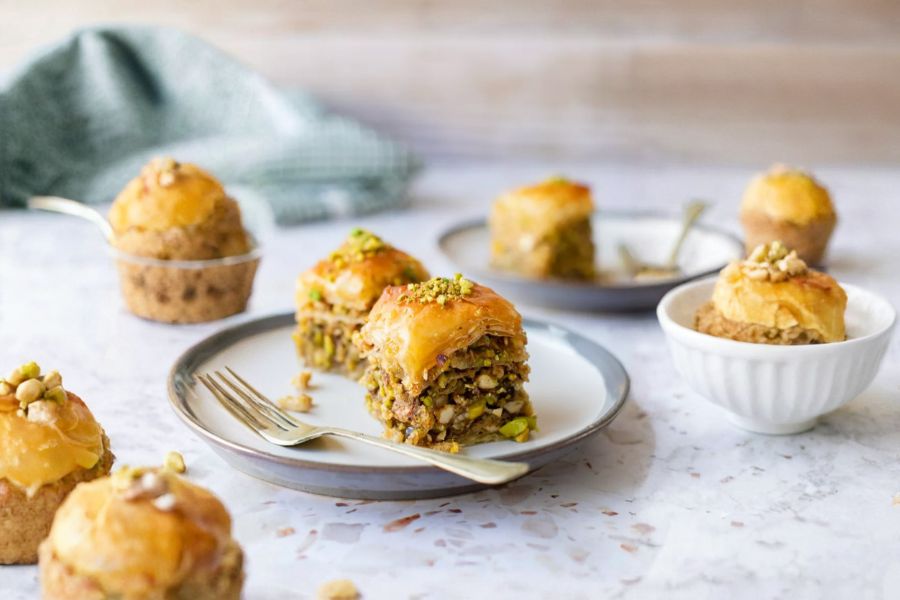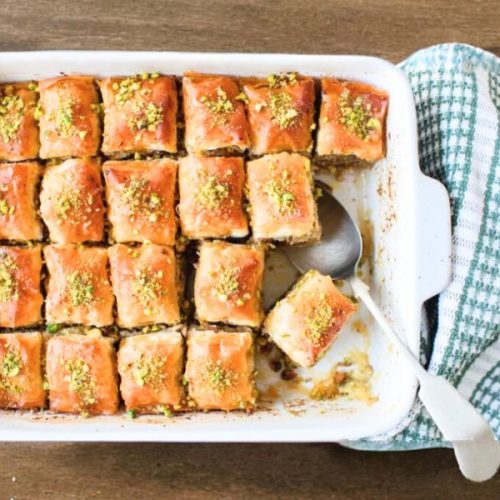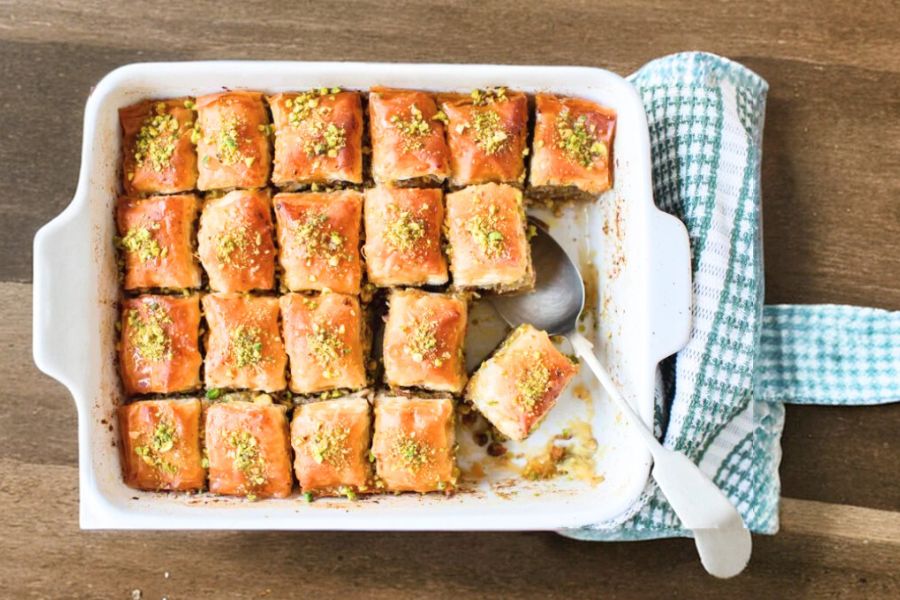Baklava is a timeless dessert that delights with its crisp, golden layers of buttery phyllo wrapped around a fragrant nut filling, all draped in a luscious honey syrup.
This version balances indulgence with wholesome qualities—nuts like walnuts, pistachios, and almonds offer plant-based protein, heart-healthy fats, and fiber that promote satiety and steady energy.
While sweet, the natural honey brings antioxidant benefits and a rich, floral sweetness that elevates every bite.
Despite its luxurious appearance, baklava is surprisingly easy to prepare and can be made ahead, making it perfect for gatherings or as a ready-to-serve treat for the week.

Its long shelf life and room-temperature storage make it ideal for meal prep, and its combination of texture, flavor, and nutrition ensures it’s as satisfying to eat as it is beautiful to serve.
Must-Have Tools for Perfect Results
OXO Good Grips Silicone Pastry Brush
Effortlessly applies melted butter between phyllo layers without tearing delicate sheets. Ideal for glazing breads, pastries, and even barbecue marinades.
Cuisinart 14-Cup Food Processor
Quickly and evenly chops nuts for a fine, consistent texture—perfect for baklava or any recipe requiring precise chopping or grinding.
Wilton 9×13-Inch Nonstick Baking Pan
Ensures even baking and easy release, whether for baklava, brownies, or casseroles. Built to last and versatile for countless recipes.
Mercer Culinary Millennia Chef’s Knife
Makes clean, precise cuts when scoring baklava before baking and is an all-purpose workhorse for vegetables, meats, and herbs.
All-Clad Stainless Steel Saucepan
Heats honey syrup evenly without scorching. A go-to piece for sauces, soups, and everyday cooking.

Easy & Tasty Baklava
Equipment
- 1 Pastry brush
- 1 Food Processor
- 1 9×13-inch baking pan
- 1 Chef’s Knife
- 1 Small Saucepan
- 1 Mixing Bowl
- 1 Measuring cups & spoons set
Ingredients
For the Baklava:
- 454 g 1 lb mixed nuts (walnuts, pistachios, almonds, or combination)
- 454 g 1 lb phyllo dough, thawed
- 240 ml 1 cup unsalted butter, melted
- 67 g 1/3 cup granulated sugar
- 1 tsp ground cinnamon
- 1/3 tsp ground cloves
For the Syrup:
- 240 ml 1 cup water
- 200 g 1 cup granulated sugar
- 120 ml 1/2 cup honey
- 2 tbsp lemon juice
- 1 cinnamon stick
- Finely ground pistachios for garnish optional
Instructions
- Thawing the Phyllo Dough: Thaw the phyllo dough carefully by transferring it from the freezer to the refrigerator the night before you plan to bake, allowing it to soften gradually. Keep the dough wrapped in its original packaging or cover with plastic wrap to prevent it from drying out. Handle gently when ready to use, as phyllo is delicate and can tear easily if rushed.
- Preheating and Preparing the Pan: Prepare your baking environment by preheating the oven to 350°F (175°C) to ensure even cooking. Lightly grease a 9×13-inch baking pan with butter or nonstick spray to prevent sticking. This step ensures the baklava bakes evenly and releases cleanly from the pan when finished.
- Preparing the Nut Filling: Pulse the nuts for uniform texture using a food processor until they are finely chopped but not powdered, preserving a little bite for texture. Transfer to a mixing bowl and blend in sugar, cinnamon, and ground cloves, combining the flavors thoroughly. This mixture forms the flavorful core of the baklava, giving every bite a rich, aromatic crunch.
- Melting the Butter: Melt the butter gently in a small saucepan or microwave-safe bowl until fully liquid and warm, making it easy to brush onto phyllo layers. Keep it warm as you work to prevent the phyllo from cooling too quickly, which can cause it to crack. Buttering each layer ensures the baklava turns crisp, golden, and evenly cooked.
- Layering the First Phyllo Sheets: Create the base layers of phyllo by placing a sheet into the prepared pan and brushing it generously with melted butter. Repeat this process with 7 more sheets, creating a sturdy, buttery foundation that will support the nut filling while producing delicate, crisp layers. Cover unused sheets with a damp towel to prevent drying while you work.
- Adding the Nut Filling: Spread a thin, even layer of the nut mixture over the phyllo base, ensuring the layer reaches the edges but isn’t too thick. Then, carefully place two more phyllo sheets on top, brushing each with melted butter, creating alternating layers of nut filling and phyllo. Repeat this process until all the nut mixture is used, finishing with 8 buttered phyllo sheets on top.
- Scoring the Baklava: Score the layered baklava carefully using a sharp chef’s knife, cutting through all layers to form 24 evenly sized squares. Scoring ensures the syrup penetrates each piece fully and makes cutting the finished baklava clean and easy. A precise score also helps the baklava bake evenly without cracking or puffing irregularly.
- Baking the Baklava: Bake the baklava evenly at 350°F (175°C) for 30–35 minutes, or until the top layers are golden brown and crisp at the edges. Monitor closely to prevent over-browning, rotating the pan if necessary for uniform color. Baking transforms the delicate layers into a crisp, flaky masterpiece with a rich aroma filling the kitchen.
- Preparing the Honey Syrup: Simmer the honey syrup gently by combining water, sugar, honey, lemon juice, and a cinnamon stick in a small saucepan. Bring to a boil, then reduce heat to medium-low and simmer for about 7 minutes until slightly thickened, stirring occasionally to dissolve sugar completely. Remove the cinnamon stick and allow the syrup to cool to room temperature before pouring over hot baklava.
- Pouring the Syrup: Spoon the cooled syrup evenly over the hot baked baklava, ensuring every cut and corner absorbs the liquid. The syrup will seep into the scored lines and infuse the nuts, giving a sweet, sticky finish that contrasts perfectly with the crisp phyllo. Let the baklava rest uncovered for at least 4 hours to fully absorb the syrup and achieve the ideal texture
Notes
- Thaw phyllo properly: Always thaw phyllo dough in the refrigerator overnight to prevent tearing and ensure pliability.
- Keep phyllo covered: Place a damp towel over sheets while working to stop them from drying out.
- Nut variations: Use any combination of walnuts, pistachios, and almonds, or try pecans or hazelnuts for a personal twist.
- Butter generously: Brushing each layer ensures a crisp, golden texture; don’t skimp.
- Syrup timing: Pour cooled syrup over hot baklava to allow proper absorption without sogginess.
- Scoring carefully: Score before baking to make cutting easier and ensure syrup penetration.
- Make-ahead friendly: Baklava can be made a day or two in advance; flavor improves as it rests.
Chef’s Secrets For Perfect Layers
Achieving perfectly crisp and golden baklava relies on attention to layering and buttering.
Always brush each phyllo sheet thoroughly with melted butter to ensure even browning and a flaky texture.
Use a sharp knife to score the baklava in clean, straight lines before baking, which allows the syrup to penetrate fully.
For added flavor, lightly toast the nuts before pulsing them, which enhances their natural aroma and adds depth to the final dish.
Finally, allow the syrup to cool slightly before pouring over the hot baklava—this prevents over-saturation while ensuring each layer is sweetly infused.
Serving Suggestions For Baklava Delight
Baklava is versatile and pairs beautifully with a variety of accompaniments.
Serve it alongside a strong coffee, black tea, or sweet dessert wine to balance its rich sweetness.
You can also enjoy it with a dollop of lightly whipped cream, Greek yogurt, or a sprinkle of extra ground pistachios for a sophisticated presentation.
For festive occasions, consider arranging it on a platter with fresh berries or edible flowers to enhance its visual appeal.
This dessert shines both at casual gatherings and holiday celebrations.
Storage Tips To Preserve Freshness
Store baklava at room temperature in an airtight container for up to two weeks to maintain crisp layers and syrupy sweetness.
If storing in the refrigerator, the texture may become firmer, but the flavor will remain excellent.
To refresh slightly hardened baklava, place it in a warm oven for a few minutes before serving.
For long-term storage, baklava freezes well: wrap tightly in plastic wrap and aluminum foil, then thaw at room temperature before serving. These methods ensure that every piece remains flavorful and tender.
Common Questions About Baklava
1. Can I use store-bought nuts?
Yes! Pre-chopped or whole nuts from the store work well. Pulse them in a food processor to the desired texture for the filling. Toasting them lightly before pulsing enhances their flavor.
2. How long can baklava sit after syrup?
Baklava should sit at least 4 hours after pouring the syrup for optimal absorption. Overnight resting improves flavor and texture even more, making it ideal for make-ahead preparation.
3. Can I substitute butter with oil?
Butter is preferred for authentic flavor and crispness, but a mild, neutral oil can be used in a pinch. The texture may be slightly less flaky but still delicious.
4. Why is my baklava soggy sometimes?
Soggy baklava usually results from pouring hot syrup over cold baklava or using too much syrup. Always pour cooled syrup over hot baklava for balanced absorption and crispness.
5. Can baklava be made gluten-free?
Yes! Some specialty stores carry gluten-free phyllo sheets. Follow the recipe exactly, but handle the dough gently, as gluten-free phyllo can be more fragile.
This recipe has been adapted and simplified from the original version by simplyrecipes. We’ve refined the steps for a smoother cooking experience and added helpful notes, nutrition insights, and essential kitchen tools to make it even easier for home cooks.

